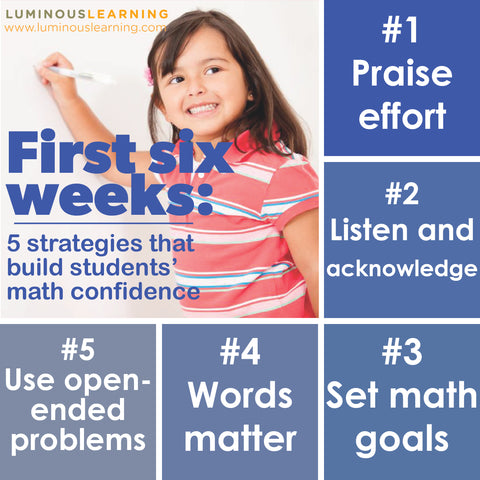First six weeks: 5 teaching strategies to build math confidence
The first six weeks of school are important for the success of the rest of the school year. The routines and guidelines you establish in the first six weeks of school will set your classroom and students up for a year of productive math learning.
Below are 5 teaching strategies to help students build their math confidence and decrease anxiety. Practice doing these 5 things in the first six weeks of school. If these teaching strategies become a habit, you will establish a successful math classroom!
Build math confidence and decrease math anxiety
Students who lack math confidence tend to doubt their abilities and avoid putting themselves on the spot by answering questions in class. These students are easy to spot: they don’t make eye contact and keep their heads down when you ask questions. They aren’t sure of their answers and hesitate when you ask them to explain how they solved a problem.
It’s important for students to become confidence math learners. When they’re confident, they’re unafraid to make mistakes and more likely to challenge themselves by trying to solve more advanced, tricky math problems. In turn, this helps them to increase their math skills.
Students may not develop math confidence on their own, but us teachers can use certain strategies to build their confidence. We can help them realize the depth of knowledge they already possess and increase their pride in their work and the effort they put into learning math.

Here are some teaching strategies to build students’ math confidence:
1. Praise effort:
Praise students for their effort, not for their intelligence or the accomplishment of getting the right answer. Avoid saying, “You’re so smart! I knew you’d get this problem right.” This makes students think that math abilities are predetermined by innate intelligence. Instead, students should be taught that success in math is determined by the time and hard work they put into learning. For example, say, “Great job working hard on this math problem. I know fractions can be tricky, but if you keep putting in effort, you’ll get it.” Similarly, limit empty or generic praise, such as, “Good job.”
2. Listen and acknowledge:
Take time to ask students how they solved a problem and genuinely listen to their answers, without correcting their mistakes. Use this as an opportunity to assess their understanding and find out what they know about a topic. While there are certainly moments when you want to correct students’ misunderstanding, you also want to show them that you value their interpretations and methods of solving a problem. Use this assessment data to plan small group instruction or one-on-one conferencing to correct any misunderstandings.
3. Set math goals:
Take time in the first six weeks to set realistic goals, or better yet, have students set their own math goals. As the school year progresses, these goals will help students see how much math they’ve learned. Track students’ progress towards meeting these goals to make their growth visible. For example, students can write their math goals on a chart. Revisit their goals periodically throughout the school year and chart their progress. When students meet their math goal, celebrate and set a new one! Make sure to remind them that it was their hard work that helped them accomplish their goals and learn more math.
4. Words matter:
Be careful how you describe your own experiences with math! Even if it’s not your favorite subject, avoid telling students that you’re bad at math. Students are quick to internalize a teacher’s beliefs and make those beliefs their own. Similarly, avoid telling a student that “they’re just not a math student.” This will convey the false belief that they simply weren’t born with a math brain, which gives them an excuse not to study hard to learn the subject. Instead, tell students that everyone can become good at math if they work hard and challenge themselves to constantly learn more.
5. Use open-ended problems:
Give math problems that don’t have one just one right or wrong answer. This allows students to approach the problem using different strategies. When discussing the problem with the class, have a few students share how they solved the problem. Celebrate the fact that each of them approached the problem in unique ways and reiterate how math is dynamic and allows for different ways of thinking. Also, emphasize that getting the right answer is not the goal, but rather developing mathematical thinking as students go through the process of solving the problem is the goal.
Try one or more of these 5 techniques and leave a comment to let us know how it worked!

